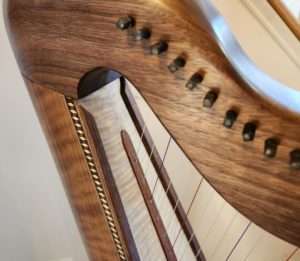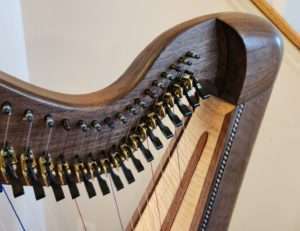Sneaking up on you?
When you are practicing (or performing) do you ever get the sensation that something’s not quite right? Like something is sneaking up on you?
I work with a lot of people as a teacher, a workshop presenter, a performer, and as an ergonomist. From my perch I can see it – and you’re probably right. Something is sneaking up on you.
Your shoulders.
Yup, those pesky pendents upon which we are so de-pendent. Literally – our arms hang from our shoulders. Our wrists are (still) at the ends of those arms. And dangling at the end of that chain – our fingers. Yes, our shoulders are pretty important.
But we get busy. There’s all that playing to do. Remembering the notes, forgetting our fingering, finding the right measure we need to be reading, possibly playing faster than we’re ready to. We are focused on a number of (granted, very important) things. And what we don’t have is brain space to focus on is often…our shoulders.
So, they creep up. They’re trying to help, but in their zeal to be supportive, they increase our tension, pull our arms out of their natural (relaxed) posture and requiring more energy to hold our arms, wrists, and fingers in the appropriate place to play the music the way we are wont to. And all of that makes it harder to play, which is distracting – and stressful. You can see how this can easily become a vicious (and possibly viscous) circle.
Stop it. How? you might ask. Well, I’m delighted to share that I have just the thing! Try this:
- Record your playing (you knew this would come up). Why? So you can see where and when your shoulders start to travel. This can be as simple as poor posture which you can improve by setting yourself in a good neutral posture from the minute you touch the bench. But what if you’re a stress shrugger? Do your shoulders keep company with your ears when the going gets tough? Well, a video will help you find your triggers.
- Once you know what it is that sets your shoulders off, then you can focus on correcting it. Your triggers might be playing faster than you’re ready, coming to a “tricky” part that you’re not really comfortable with yet, or that you’re not breathing, or just not relaxing into your playing. The video will help you find out what is happening – and when – so you can work on it.
- Once you know what triggers your shoulders’ to travel, then set a random timer (here’s a free one on the internet and here’s another one) to give you a signal at various times. When it dings, freeze, and check your shoulders. Are they where you’d expect and want them to be? Or did you run out of focus doing other things? Since this is random, it gives you time to stop thinking about your shoulders and the ding serves as a reminder to make sure they are down. If the ding happens and your shoulders are at your ears – don’t stop playing, just drop and relax them and keep going. You want to learn to detect that you’re shrugged and relax.
- Breathe! (Do I need to say more than that? I didn’t think so, but I will) Breathe like you mean it since it will not only relax you but also help keep your mind clear and present.
- Take breaks throughout your practice. Think about practicing in 20-minute segments (with a timer, because it helps). At the end of each segment, breathe, stretch, move around, get up off the bench, and let your whole system rest for a sec. Then you can come back to the next segment ready to go.
- Be kind to yourself. This might take a while. After all, you unknowingly developed the habit of tensing your shoulders and now you will consciously go about undeveloping that habit and learning to be more relaxed. Unlearning (to shrug) and relearning (to relax) takes longer than the initial learning, so be gentle on you – reward yourself for your continued growth. And don’t lose momentum, this is something that will come with time and practice.
It is important to get your shoulders dropped when you’re practicing – if you work in that tension, you will train yourself to play with that tension. You will actually ingrain that stress in your shoulders which, as mentioned above, impacts your playing.
If you’re still Team “I’m not comfortable on video” you can use a full-length mirror – but also, get over yourself, you’re not making a Hollywood extravaganza or even a social media video. You are using a valuable tool to help you grow. Just do it (it’s also faster than using the mirror because you can practice, and then review the video when you’re finished – none of that pesky trying to “catch yourself” while you’re also practicing!
Are your shoulders sneaking up on you? Let me know what you do (or what you’re going to try) – in the comments!






